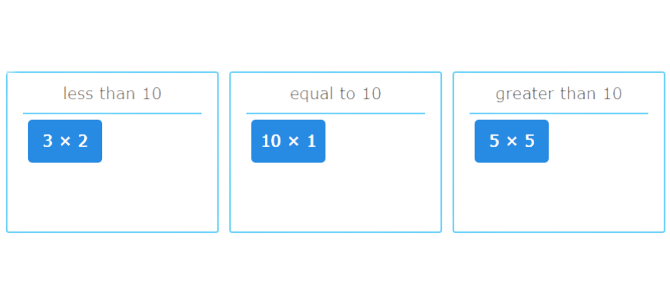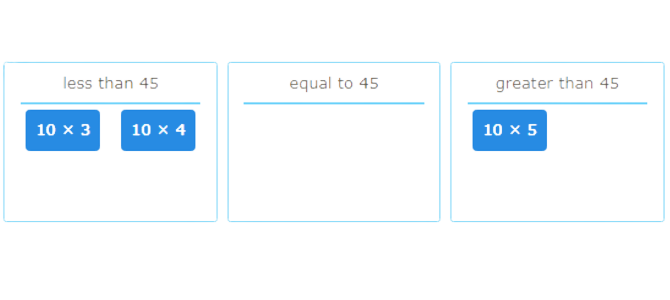Multiplication facts for 2, 3, 4, 5, 10: sorting
Key Notes :
Multiply by 2

💡 Twice a number to get a multiple of 2
👇 Multiplication table of 2
- 2 × 0 =0
- 2 × 1 =2
- 2 × 2 =4
- 2 × 3 =6
- 2 × 4 =8
- 2 × 5 =10
- 2 × 6 =12
- 2 × 7 =14
- 2 × 8 =16
- 2 × 9 =18
- 2 × 10 =20
- 2 × 11 =22
- 2 × 12 =24
Multiply by 3

Multiplication is adding the same number repeatedly.
To multiply by 3, you add a number to itself 3 times.
What’s 2 × 3?
You can draw equal groups to help figure it out.

2 × 3 is a shortcut for writing:
2 + 2 + 2 = 6
Tip: Do skip-counting in your head to figure it out:
2, 4, 6
The Multiplication Table of 3
- 3×1 =3
- 3×2 =6
- 3×3 =9
- 3×4 =12
- 3×5 =15
- 3×6 =18
- 3×7 =21
- 3×8 =24
- 3×9 =27
- 3×10 =30
Multiply by 5

Multiplying by 5 is like skip counting by the other factor 5 times!
Ex: 2 x 5 =?
2 + 2 + 2 + 2 + 2 = 10
Multiplication Table of 5
- 5×1= 5
- 5×2= 10
- 5×3= 15
- 5×4= 20
- 5×5= 25
- 5×6= 30
- 5×7= 35
- 5×8= 40
- 5×9= 45
- 5×10= 50
Multiply by 10
Any time we multiply a whole number by 10 we’re gonna keep the original number and simply add a zero to the end.
1 × 10 = 10
2 × 10 = 20
3 × 10 = 30
4 × 10 = 40
5 × 10 = 50

multiplication table of 10
- 1 × 10 = 10
- 2 × 10 = 20
- 3 × 10 = 30
- 4 × 10 = 40
- 5 × 10 = 50
- 6 × 10 = 60
- 7 × 10 = 70
- 8 × 10 = 80
- 9 × 10 = 90
- 10 × 10 = 100
- 11 × 10 = 110
- 12 × 10 = 120
💡 Multiplying a number by 10 is the same as adding a number to itself 10 times.
3 x 10 = ?
To figure out the answer, we can do repeated addition:
3 + 3 + 3 + 3 + 3 + 3 + 3 + 3 + 3 + 3 =30 😅
| equal to 25 | greater than 25 | less than 25 |
| 5×5 | 10×5 | 5×4 |
| 10×4 | 3×3 |
| equal to 50 | greater than 50 | less than 50 |
| 10×5 | 10×6 | 5×5 |
| 10×7 | 5×4 |
Learn with an example
Multiply to find the products. Is each product less than 12, equal to 12, or greater than 12?
Place each expression into the correct box.
- 10 x 4
- 4 x 5
- 5 x 5

Look at one expression at a time.
Multiply to find the product of each expression. Then, compare the product to 12.
10 x 4
The expression 10×4 means 10 groups of 4.
4 + 4 + 4 + 4 + 4 + 4 + 4 + 4 + 4 + 4 = 40
10 × 4 = 40
10 ×4 belongs in the less than 12 boxes.
4 × 5
The expression 4×5 means 4 groups of 5.
5 + 5 + 5 + 5 = 20
4 × 5 = 20
4 × 5 belongs in the greater than 12 box.
5 x 5
The expression 5×5 means 5 groups of 5.
5 + 5 + 5 + 5+ 5 = 25
5 x 5 = 25
5 × 5 belongs in the greater than 12 box.
Place each expression into the correct box.

Multiply to find the products. Is each product less than 10, equal to 10, or greater than 10?
Place each expression into the correct box.
- 10 x 1
- 5 x 5
- 3 x 2

Look at one expression at a time.
Multiply to find the product of each expression. Then, compare the product to 10.
10 × 1
The expression 10×1 means 10 groups of 1.
1 + 1 + 1 + 1 + 1 + 1 + 1 + 1 + 1 + 1 = 10
10 × 1 = 10
10×1 belongs in the equal to 10 box.
5 × 5
The expression 5 × 5 means 5 groups of 5.
5 + 5 + 5 + 5 + 5 = 25
5 × 5 = 25
5 × 5 belongs in the greater than 10 box.
3 × 2
The expression 3 × 2 means 3 groups of 2.
2 + 2 + 2 = 6
3 × 2 = 6
3×2 belongs in the less than 10 box.
Place each expression into the correct box.

Multiply to find the products. Is each product less than 45, equal to 45, or greater than 45?
Place each expression into the correct box.
- 10 x 3
- 10 x 4
- 10 x 5

Look at one expression at a time.
Multiply to find the product of each expression. Then, compare the product to 45.
10×3
The expression 10×3 means 10 groups of 3.
3 + 3 + 3 + 3 + 3 + 3 + 3 + 3 + 3 + 3 = 30
10 × 3 = 30
10 × 3 belongs in the less than 45 box.
10 × 4
The expression 10× 4 means 10 groups of 4.
4 + 4 + 4 + 4 + 4 + 4 + 4 + 4 + 4 +4 = 40
10 × 4 = 40
10 × 4 belongs in the less than 45 box.
10 × 5
The expression 10 × 5 means 10 groups of 5.
5 + 5 + 5 + 5 + 5 + 5 + 5 + 5 + 5 + 5 = 50
10 × 5 = 50
10 × 5 belongs in the greater than 45 box.
Place each expression into the correct box.

Let’s practice!

